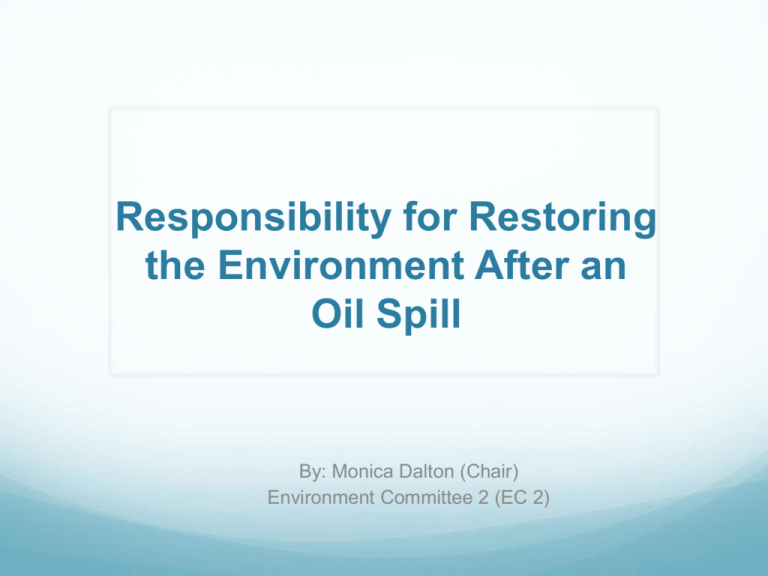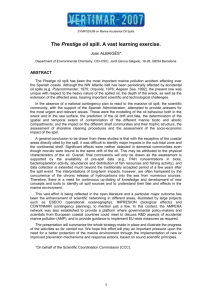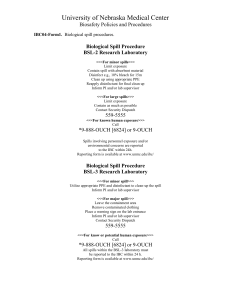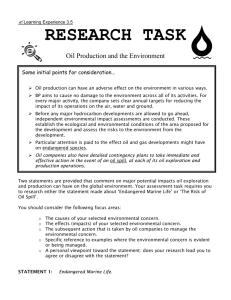Responsibility for restoring the environment after an oil spill
advertisement

Responsibility for Restoring the Environment After an Oil Spill By: Monica Dalton (Chair) Environment Committee 2 (EC 2) OIL SPILLS Definition of Key Terms Responsibility is defined as: The state or fact of being accountable or to blame for something. Restoring is defined as: The process of returning of something to a former, original, normal, or unimpaired condition. An Oil Spill is defined as: An accidental release of oil into a body of water, as from a tanker, offshore drilling rig, or underwater pipeline, often presenting a hazard to marine life and the environment. Topic Summary … Oil is the world economy’s most important source of energy. “The availability of liquid petroleum in the form of crude oil and its refined products is a key driver for all sorts of activities in modern society” Petroleum products power virtually all motor vehicles, aircraft, marine vessels, and trains around the globe. Refined fuels provide more than 90% of the world’s transportation energy. In total, products derived from oil, such as motor gasoline, jet fuel, diesel fuel, and heating oil, supply nearly 40% of the energy consumed by households, businesses, and manufacturers worldwide. Topic Summary … In the United States, long stretches of beaches are often closed because of medical and other waste washing up on shore. And every time an oil tanker is involved in an accident, the world's pulse quickens a bit in fear of a major catastrophe, In fact, every time a tanker cleans its tanks at sea, every time a factory channels toxic residues to coastal waters or a city conveniently releases raw sewage into the sea, every time a service station changes the oil of an automobile and pours the waste oil into the sewers, the oceans become a little more polluted. Eventually, scientists fear, the oceans' regenerative capacity will be overwhelmed by the amount of pollution it is subjected to by man. Signs of such catastrophe are clearly observed in many seas—particularly along the heavily populated coasts and enclosed or semi-enclosed seas. … Topic Summary Oil spills have severe consequences towards the environment. When an oil slick from a large oil spill reaches the beach, the oil coats and clings to every rock and grain of sand. If the oil washes into coastal marshes, mangrove forests or other wetlands, fibrous plants and grasses absorb the oil, which can damage the plants and make the whole area unsuitable as wildlife habitat. When some of the oil eventually stops floating on the surface of the water and begins to sink into the marine environment, it can have the same kind of damaging effects on fragile underwater ecosystems, killing or contaminating many fish and smaller organisms that are essential links in the global food chain. Thus oil spills can severely harm and threaten the existence or marine ecosystems. … Topic Summary Also there is the issue of a lack of responsibility. When these oil spills occur, companies and nations are often unwilling to take the blame and thus start working towards solving the issue. There is a wastage of time spent debating who is responsible for restoring the environment, whilst there is suffering due to the oil spills, when restoration plans should be taking place. The lack of responsibility is enhancing the issue and making the damages worse. Timeline 1 This is a timeline of the BP Oil Spill, one of the most recent and largest oil spills. Millions of gallons of oil have poured into the Gulf of Mexico since an April 20 blast on the Deepwater Horizon rig triggered a huge spill, soiling 100 miles of coastline, threatening some of the United States' richest fisheries and endangering a fragile ecosystem. March 2008 – The mineral rights to drill for oil at the Macondo well, located in Mississippi Canyon Block 252 in the United States sector of the Gulf of Mexico about 41 miles (66 km) off the Louisiana coast, were purchased by BP at the Minerals Management Service's (MMS) Lease Sale #206, held in New Orleans. February 2009 – BP files a 52 page exploration and environmental impact plan for the Macondo well with the MMS. The plan stated that it was "unlikely that an accidental surface or subsurface oil spill would occur from the proposed activities".[7] In the event an accident did take place the plan stated that due to the well being 48 miles (77 km) from shore and the response capabilities that would be implemented, no significant adverse impacts would be expected. April 6 – The Department of the Interior exempted BP's Gulf of Mexico drilling operation from a detailed environmental impact study after concluding that a massive oil spill was unlikely. October 7 – The Transocean Marianas semi-submersible rig begins drilling the Macondo well. November 9 – Hurricane Ida damages Transocean Marianas enough that it has to be replaced. February 15, 2010 – Deepwater Horizon drilling rig, owned by Transocean, begins drilling on the Macondo Prospect. The planned well was to be drilled to 18,000 feet (5,500 m) below sea level, and was to be plugged and suspended for subsequent completion as a subsea producer. March 8 – Target date for the completion of the well which had been budgeted to cost $96 million. March 17 – BP Chief Tony Hayward sells one third of his BP stock (223,288 shares). Closing BP price on March 17 on the New York Stock Exchange is 58.15. March – An accident damages a gasket on the blowout preventer on the rig. Timeline 2 April 20, 2010 - Explosion and fire on Transocean Ltd's drilling rig Deepwater Horizon licensed to BP; 11 workers are killed. The rig was drilling in BP's Macondo project 42 miles southeast of Venice, Louisiana, beneath about 5,000 feet of water and 13,000 feet under the seabed. April 22 - The Deepwater Horizon rig, valued at more than $560 million, sinks and a five mile long oil slick is seen. April 25 - The Coast Guard says remote underwater cameras detect the well is leaking 1,000 barrels of crude oil per day. It approves a plan to have remote underwater vehicles activate a blowout preventer and stop leak. Efforts to activate the blowout preventer fail. April 28 - The Coast Guard says the flow of oil is 5,000 barrels per day (bpd) (210,000 gallons/795,000 liters) -- five times greater than first estimated. A controlled burn is held on the giant oil slick. April 29 - Obama pledges "every single available resource," including the U.S. military, to contain the spreading spill.-- Obama also says BP is responsible for the cleanup. Louisiana declares state of emergency due to the threat to the state's natural resources. April 30 - An Obama aide says no drilling will be allowed in new areas, as the president had recently proposed, until the cause of the Deepwater Horizon accident is known.-- BP Chairman Tony Hayward says the company takes full responsibility for the spill and would pay all legitimate claims and the cost of the cleanup. Timeline 3 May 2 - Obama visits the Gulf Coast to see cleanup efforts first hand. U.S. officials close areas affected by the spill to fishing for an initial period of 10 days. BP starts to drill a relief well alongside the failed well, a process that could take two to three months to complete. May 5 - A barge begins towing a 98-ton containment chamber to the site of the leak. BP says one of the three leaks has been shut off by capping a valve, but that would not cut the amount of oil gushing out. May 6 - Oil washes ashore on the Chandeleur Islands off the Louisiana coast, uninhabited barrier islands that are part of the Breton National Wildlife Refuge. May 7 - BP tries to lower a containment dome over the leak, but the 100-tonne device was rendered useless by a slush of frozen hydrocarbons that clogged it. -- A fishing ban for federal waters off the Gulf is modified, expanded and extended to May 17. May 9 - BP says it might try to plug the undersea leak by pumping materials such as shredded up tires and golf balls into the well at high pressure, a method called a "junk shot.” May 11/12 - Executives from BP, Transocean and Halliburton appear at congressional hearings in Washington. Senate Energy committee chairman Jeff Bingaman says that it appeared that the explosion on the rig was due to a "cascade of errors, technical, human and regulatory. The executives blame each other's companies. Timeline 4 May 14 - Obama slams companies involved in the spill, criticizing them for a "ridiculous spectacle" of publicly trading blame over the accident in his sternest comments yet. May 16 - BP succeeds in inserting a tube into the leaking well and capturing some oil and gas. May 18 - The U.S. nearly doubles a no-fishing zone in waters affected by the oil, extending it to 19 percent of U.S. waters in the Gulf. May 19 - The first heavy oil from the spill sloshes ashore in fragile Louisiana marshlands and part of the mess enters a powerful current that could carry it to Florida and beyond. May 26 - A "top kill" maneuver starts involving pumping heavy fluids and other material into the well shaft to stifle the flow, then sealing it with cement. May 28 - Obama tours the Louisiana Gulf coast on his second visit - "I am the president and the buck stops with me," he said.-- BP CEO Tony Hayward flies over the Gulf. BP says that the cost of the disaster so far is $930 million. May 29 - BP says the complex "top kill" maneuver to plug the well has failed, crushing hopes for a quick end to the largest oil spill in U.S. history already in its 40th day. May 31 - The U.S. government and BP are warning that the blown-out oil well may not be stopped until August as the company prepares a new attempt to capture leaking crude. Timeline 5 June 1 - BP shares plunge 17 percent in London trading, wiping $23 billion off its market value, on news its latest attempt to plug the well has failed. August 2Flow Rate Technical Group reports that the well initially was dumping 62,000 barrels of oil per day initially after the spill and that it dwindled to 53,000 barrels when it was capped as the well was depleted. This means that 4.9 million barrels were dropped into the Gulf. Environmental Protection Agency releases a study of eight dispersants which concludes that Corexit 9500 "is generally no more or less toxic than mixtures with the other available alternatives" and that "dispersant-oil mixtures are generally no more toxic to the aquatic test species than oil alone.” August 4 – BP reports that the well achieved “static condition” shortly after midnight after drilling mud is said to now fill the well. August 14 – Obama on a one-night vacation stays at the Back Bay Marriott in Panama City, Florida. The White House releases a photo of Obama and Sasha Obama swimming in St. Andrew's Bay (Florida) near Alligator Point. The Press was not present during the swim. September 29 – Andy Inglis, who headed deepwater drilling operations in the Gulf of Mexico at the time of the spill, steps down as head of the upstream business.[127]September 30 – Dudley tells the Houston Chronicle, "We don't believe we have been grossly negligent in anything we've seen in any of the investigations." Dudley also announces BP will create a stronger safety division. October 1 – Allen steps down. December 15 - According to a feature Associated Press story on the homepage of Time Magazine, the U.S. federal government is suing BP Exploration and Production, Inc., and eight other corporations, for unlimited liability, in an effort to have them pay for the massive expenses involved in the cleanup and environmental recovery from the spill, including damages to natural resources; it also seeks civil penalties under the Clean Water Act. December 17 - Unified Area Command releases the report from the Operational Science Advisory Team (OSAT) regarding results of sampling and analyses of thousands of water column and sediment samples from the shoreline through deepwater areas. How this Topic Originated? Oil Spills originated in the 20th century and the first major oil spill was March 18 1967 in the United Kingdom - The Torrey Canyon ran aground off Cornwall spilling 80,000 tonnes (919,000 barrels) of crude. This oil spill was followed by the Exxon Valdez Oil Spill another major oil spill that took place on March 23, 1989 at Prince William Sound in Alaska. The drivers of the Exxon Valdez noticed icebergs in their planned route. Instead of trying to weave through the icebergs, they decided to go in another direction. On the new route, the oil tanker hit shallow land. The shallow land was not a beach, it was called Bligh Reef. The Exxon Valdez spilled about 125 Olympic-sized swimming pools. The Exxon Valdez affected many animals at Prince William Sound in Alaska. The spill greatly affected sea otters and sea birds. There were about 2,800 sea otters and 250,000 seabirds killed by the spill. Harbor seals, bald eagles, killer whales, and salmon were also greatly affected by the spill. Many people complained about the large amount of sea otters dumped in crude oil because Prince William Sound was a tourist attraction. Many people came to Prince William Sound to visit the animals. Oil spills have continue to occur ever since as oil is the most important source of energy and there are many accidental releases of oil into a body of water, as from a tanker, offshore drilling rig, or underwater pipeline, which unfortunately often present hazards to the environment. UN Involvement The United Nations and the Law of the Sea Throughout the years, beginning with the work of the Seabed Committee in 1968 and later during the nine-year duration of the Third United Nations Conference on the Law of the Sea, the United Nations has been actively engaged in encouraging and guiding the development and eventual adoption of the Law of the Sea Convention. Today, it continues to be engaged in this process, by monitoring developments as they relate to the Convention and providing assistance to States, when called for, in either the ratification or the implementation process. The goal of the Organization is to help States to better understand and implement the Convention in order to utilize their marine resources in an environment relatively free of conflict and conducive to development, safeguarding the rule of law in the oceans. In this context, the Division for Ocean Affairs and the Law of the Sea (DOALOS) of the United Nations Office of Legal Affairs helps to coordinate the Organization's activities and programmes in the area of marine affairs. It is active in assisting and advising States in the integration of the marine sector in their development planning. It also responds to requests for information and advice on the legal, economic and political aspects of the Convention and its implications for States. Such information is used by States during the ratification process, in the management of the marine sector of their economies and in the development of a national sea-use policy. The United Nations also gives assistance to the two newly created institutions - the International Seabed Authority and the International Tribunal for the Law of the Sea. The UN is also actively involved in all of the major oil spills and organizing the responsibility for the spills and the restoration of the environment affected by the oil spills. Long Term Objectives Long Term Objectives involve preventing future oil spills, spreading awareness about the need to take responsibility for oil spills in order to protect the environment. Also, it is important that nations adhere to the Law of the Sea in specific reference to the maritime sector. It is also important to aim to reduce the amount of oil spills and thus reduce the amount of damaged ecosystems and dying marine life. A major challenge will be to provide the necessary assistance, particularly to developing States, in order to allow them to benefit from the rights they have acquired under the new regime. For example, a great many of the States that have established their EEZs are not at present in a position to exercise all their rights and perform duties under the Convention of the Law of the Sea. The delimitation of EEZ, the surveying of its area, its monitoring, the utilization of its resources and, generally speaking, its management and development are long-term endeavors beyond the present and possibly near-term capabilities of most developing countries. Long Term Objectives The United Nations will continue to play a major role in the monitoring of, collection of information on and reporting on State practice in the implementation of the new legal regime. It will also have a significant role to play in reporting on activities of States and relevant international organizations in marine affairs and on major trends and developments. This information will be of great assistance to States in the acceptance and ratification of the Convention, as well as its early entry into force and implementation. A number of new duties falls upon the Secretary-General of the United Nations. These include the depositing of charts and coordinates showing the maritime limits of coastal States and servicing of the Commission on the Limits of the Continental Shelf The Secretary-General is also called upon to convene meetings of States Parties to elect the members of the International Tribunal for the Law of the Sea and to adopt its budget. Meetings of States Parties may also be called for a Review Conference dealing with the provisions on deep seabed mining or for amending the Convention . The United Nations will continue to strengthen the cooperation that has developed over the last two decades among the organizations in the United Nations system involved in marine affairs. Such close cooperation would be of great benefit to States, since it would avoid duplication and overlapping of activities. It would also help to coordinate multidisciplinary activities related to the management of marine affairs .With the passage of time, United Nations involvement with the law of the sea is expected to expand as awareness increases that not only ocean problems but also global problems as a whole are interrelated. The Current Situation The Current Situation Oil spills continue to pose a significant risk to the environment and maritime ecosystems leading to health issues and death related problems for the majority of the marine life who have to suffer through the oil spills. Oil Spills continue to occur throughout the world. There are efforts made to reduce the amount of oil spills, but while they still exist it is important to put in place a system to decide on the responsibility for restoration of the environments affected by specific oil spills. The lack of responsibility is worsening the situation. There are constant efforts being made towards restoring environments affected by oil spills, however, now it is important to address who should take responsibility for the damage done, how this will be decided and the restoration processes that will occur. Relevant Websites http://www.un.org/depts/los/convention_agreements/conventi on_historical_perspective.htm http://www.reuters.com/article/2010/06/01/us-oil-spill-eventsidUSTRE6503IJ20100601 http://library.thinkquest.org/CR0215471/oil_spills.htm Bibliography "Oil Spill History." The Mariner Group. Web. 9 Dec. 2011. <http://www.marinergroup.com/oil-spill-history.htm>. "Oil Spills and the Environment - How Do Oil Spills Damage the Environment?" Environmental Issues - News and Information about the Environment. Web. 7 Dec. 2011. <http://environment.about.com/od/petroleum/a/oil_spills_and_environment.ht m>. "Oil Spills and the Environment - How Do Oil Spills Damage the Environment?" Thinkquest. Web. 5 Dec. 2011. <http://library.thinkquest.org/CR0215471/oil_spills.htm>. "Overview - Convention & Related Agreements." Welcome to the United Nations: It's Your World. Web. 5 Dec. 2011. <http://www.un.org/depts/los/convention_agreements/convention_historical_ perspective.htm>. "Timeline: Gulf of Mexico Oil Spill | Reuters." Business & Financial News, Breaking US & International News | Reuters.com. 01 June 2010. Web. 8 Dec. 2011. <http://www.reuters.com/article/2010/06/01/us-oil-spill-eventsidUSTRE6503IJ20100601>. Bibliography http://www.davegranlund.com/cartoons/2010/05/17/gulf-coast-oil-spill-blame/ http://blogfishx.blogspot.com/2010/08/oily-bottom-syndrome.html http://business-ethics.com/2011/04/13/1612%E2%80%98spillionaires%E2%80%99-profiteering-and-mismanagementin-the-wake-of-the-bp-oil-spill/ http://www.anorak.co.uk/251565/news/tony-haywards-bp-sailing-trip-not-linkedto-hampshire-oil-spill.html/ http://sanfrancisco.about.com/od/environmentnature/ss/sfoilspill.htm http://griffyclan007.wordpress.com/2010/06/21/bp-oil-spill-disaster/ http://roopak330.wikidot.com/stats:u-s-oil-consumption http://en.wikipedia.org/wiki/Peak_oil









